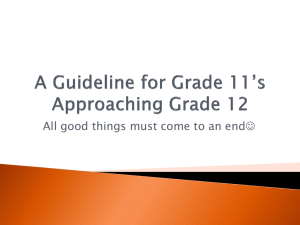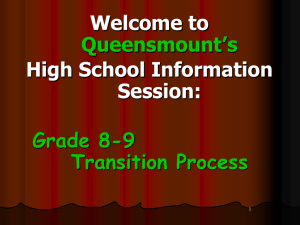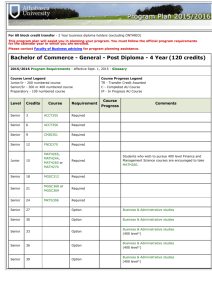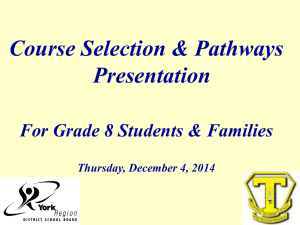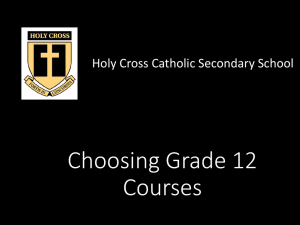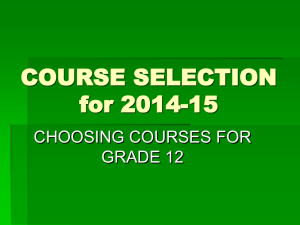Curriculum Information - Upper Canada District School Board
advertisement
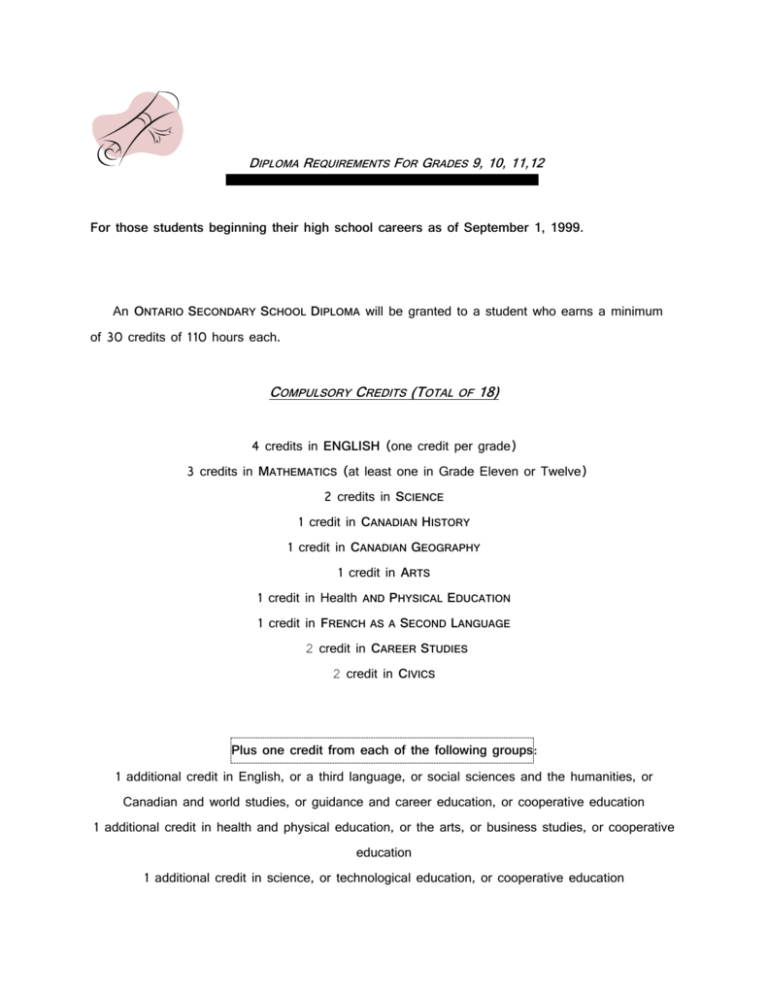
DIPLOMA REQUIREMENTS FOR GRADES 9, 10, 11,12 For those students beginning their high school careers as of September 1, 1999. An ONTARIO SECONDARY SCHOOL DIPLOMA will be granted to a student who earns a minimum of 30 credits of 110 hours each. COMPULSORY CREDITS (TOTAL OF 18) 4 credits in ENGLISH (one credit per grade) 3 credits in MATHEMATICS (at least one in Grade Eleven or Twelve) 2 credits in SCIENCE 1 credit in CANADIAN HISTORY 1 credit in CANADIAN GEOGRAPHY 1 credit in ARTS 1 credit in Health AND PHYSICAL EDUCATION 1 credit in FRENCH AS A SECOND LANGUAGE 2 credit in CAREER STUDIES 2 credit in CIVICS Plus one credit from each of the following groups: 1 additional credit in English, or a third language, or social sciences and the humanities, or Canadian and world studies, or guidance and career education, or cooperative education 1 additional credit in health and physical education, or the arts, or business studies, or cooperative education 1 additional credit in science, or technological education, or cooperative education In addition to the compulsory credits, students must complete: 12 optional credits, selected from the full list of courses available in the school. Optional credits allow students to build an educational program that suits their individual interests and meets university, college, apprenticeship, or work requirements 40 hours of community involvement activities the provincial literacy requirement THE ORGANIZATION CHART G R A D E 12 G R A D E 11 G R A D E 10 University Preparation Courses University / College Preparation Courses College Preparation Courses Transfer Courses University Preparation Courses University / College Preparation Courses College Preparation Courses Transfer Courses Workplace Preparation Courses Open Courses (for students switching course types) Workplace Preparation Courses Open Courses (for students switching course types) Academic Courses Applied Courses Open Courses Pathways Courses ”Cross-over” materials for French, English, Mathematics, Science (for students switching course types) G R A D E 9 Academic Courses Applied Courses Open Courses Pathways Courses CROSS-OVER MATERIALS Crossover materials are designed for grade 9 students who wish to take a different type of course in grade 10. Cross-over materials are offered in French, mathematics, science and English, and are released through the Independent Learning Centre branch of the Ministry of Education. These free courses (up to 30 hours) are available in the following forms: CD, Web and paper copy. Cross-over course are self-directed and self-marking. Cross-over courses are non-compulsory and non-credit. TRANSFER COURSES A transfer course is offered to students in grades 10, 11 and 12 who wish to move to another type of course in the same subject. A transfer course is a partial-credit course (.25 or .50) credit). Students who revise their educational and career goals and who wish to change room one type of course in a particular subject but lack the prerequisite course may do so by taking a transfer course. Transfer courses enable students to achieve the expectations not covered in one course type but required for entry into another course. DUAL CREDIT Students may apply to enroll in college courses or apprenticeship training, earning dual credits that count towards their OSSD and college diploma or apprenticeship certification. For example, a student interested in applying to the Police Foundations Program following graduation may opt to take one of the required courses for this program while still in high school. Interpersonal and Group Dynamics, Community and Social Services, First Nations People and Issues in Diversity and Criminal and Civil Law are examples of Police Foundation’s courses offered through the Dual Credit Program. The college courses are taught at the college campus and high school students learn alongside their college peers. A Dual Credit student typically travels to the college once or twice a week for his or her two to three hour course. Transportation to the course is the responsibility of student. Many other college programs offer courses through this initiative. The dual credit program is available through St. Lawrence College – Kingston, Brockville and Cornwall campuses and Algonquin College – Ottawa. Students who desire learning opportunities outside of high school and who would benefit from a college or apprenticeship experience are suitable candidates. To ease scheduling, many students take their dual credit course in conjunction with their high school cooperative education course. This is an excellent opportunity for students to transition to post-secondary education while still in high school. For more information please contact student services. THE GRADE 10 TEST OF READING AND WRITING SKILLS All students must pass the Grade 10 Test of Reading and Writing Skills in order to earn a Secondary School Diploma. This test is designed by the Ontario Education Quality and Accountability office. The test is administered in April and there is no limit to the number of times a student may retake the test. Accommodations may be made only for students with an IEP and in accordance with EQAO policies. Students whose Individual Education Plan indicates that the student is not working towards a Secondary School Diploma may, with parental consent and the approval of the principal, be exempted from writing the test. Students who might benefit from a deferral of the test may include students who have been identified as exceptional. A parent may request such a deferral or the principal in consultation with the parent may initiate a deferral. However, in order to achieve an Ontario Secondary School Diploma, deferred students must successfully complete the test. Students must write the test once. If they are not successful, they have the option of a re-write the next year or opt to take the Ontario Literacy Course. UPPER CANADA DISTRICT SCHOOL BOARD PATHWAYS PROGRAM This program is intended for students who: • in previous years would have been successful in Basic level courses • exhibit reading skills which are significantly below grade level but who have some basic literacy and numeracy skills • will have an IEP, and may have an IPRC (may have received resource support or alternative programming) • will require additional instruction and perhaps accommodations and/or a deferral to successfully complete the Grade 10 Literacy Test of Reading and Writing Where does the Pathways Program lead? • Grade 11 workplace courses • Apprenticeship, OYAP, or other school-to-work initiatives • Certificate of Accomplishment, or Ontario Secondary School Certificate • If the student successfully completes the Grade Ten Literacy Test of Reading and Writing, the Pathways Program can lead to a High School Diploma or “OSSD” Course Components of the Upper Canada District School Board Pathways Program: Grade 9 Grade 10 1 credit English Literacy Skills 2 1 credit English Literacy Skills 1 credit *English Applied ½ credit Essential Mathematics ½ credit Essential Science 1 credit Learning Strategies 1 1 credit Geography Applied 1 credit Physical Education 2 credits chosen from: grade 9 optional courses 1 credit *English Applied ½ credit Essential Mathematics ½ credit Essential Science 1 credit Learning Strategies 2 1 credit Canadian History Applied ½ credit Civics ½ credit Career Studies 2 credits chosen from: grade 10 optional courses *Admission to Pathways Program will be determined through consultation with the student, parents/guardians; elementary teachers, and high school Guidance/Special Education Resource personnel. Please contact the school for additional information and course descriptions. COMMUNITY INVOLVEMENT ACTIVITIES As part of the diploma requirements, students must complete a minimum of 40 hours of community involvement activities during their years in the secondary school program. Students, in collaboration with their parents, will decide how they will complete the community involvement requirement. They may use their Annual Education Plan to identify possible activities they might undertake. Community involvement activities may take place in a variety of settings (e.g. not-for-profit organizations, hospitals, informal settings, etc.) Students may not fulfill the requirement through activities that are counted towards a credit (e.g. cooperative education and work experience), through paid work, or by assuming duties normally performed by a paid employee. The requirement is to be completed outside student’s normal instructional hours - that is, the activities are to take place in students= designated lunch hours, after school, on weekends, or during school holidays. hours will be provided by the ministry. Specific procedures for students regarding completion of the 40 The principal will decide whether the student has met the requirements of both the Ministry and the Board for these activities. The Upper Canada District School Board provides each student with a brochure outlining the requirements for Community Involvement. Copies of the brochure are available from the main office or guidance office. CERTIFICATES AN ONTARIO SECONDARY SCHOOL CERTIFICATE will be granted to a student who earns a minimum of 14 credits. Compulsory Credits (Total of 7) 2 credits in ENGLISH 1 credit in MATHEMATICS 1 credit in SCIENCE 1 credit in ARTS or TECHNOLOGY 1 credit in CANADIAN HISTORY or CANADIAN GEOGRAPHY 1 Credit in PHYSICAL AND HEALTH EDUCATION Optional Credits (total of 7) In addition to the 7 compulsory credits, students have to earn 7 optional credits in courses of their choice, selected from the full list of courses available in the school. Optional credits allow students to build an educational program that suits their individual interests and meets apprenticeship or work requirements. A CERTIFICATE OF ACCOMPLISHMENT will be granted to a student who leaves school before fulfilling the requirements for the Ontario Secondary School Diploma or the Ontario Secondary School Certificate. The Certificate of Accomplishment is a way of recognizing achievement of students who plan to take other kinds of further training or who plan to find employment after school. An Ontario Student Transcript will be attached to indicate what credits have been earned. A Certificate of Accomplishment will only be issued once. HEALTHY ACTIVE LIVING CERTIFICATE This certificate is designed to recognize a student’s initiative to lead a healthy active lifestyle through the combination of academics and activity. A student must earn a minimum 4 credits in Health and Physical Education courses, 1 credit in an alternative course related to health active living., actively participate in 6 school sports teams or intramural activities, and demonstrate commitment to school and community through the successful completion of one wellness initiative. Some of these initiatives may include organizing the Terry Fox Walk, Relay for Life, or 30-Hour Famine, coaching a community sports team, assistant-coaching a school sports team, or volunteering for a nutrition program. These certificates are valuable as they identify a well-rounded individual who has demonstrated balance, initiative and commitment to a healthy active lifestyle, to post-secondary institutions or potential employers. Application forms will be available from the main office. SUBSTITUTIONS FOR COMPULSORY CREDITS In order to allow flexibility in designing a student’s program and to ensure that students can qualify for the Secondary School Diploma, substitutions may be made for a limited number of compulsory credit courses. These courses must be selected from the course offerings of the school that meet the requirements for compulsory credits. To meet individual students’ needs, the principal may replace up to three of these courses (or the equivalent in half courses) with courses that meet the compulsory credit requirements. Each substitution will be noted on the student’s Ontario Student Transcript. TYPES OF COURSES Students in Grade 9 and 10 will choose courses from one or more of four types: academic, applied, open and essential. Academic and applied courses will have similar core content, with academic courses focusing on theoretical knowledge while applied courses will focus on practical application of knowledge. All types of courses in Grade 9, provide the necessary prerequisites for all Grade 10 courses in the same discipline in any stream. In the academic course, the essential concepts of a subject are learned and related material explored as well. Although the knowledge and skills in the subject will be developed through both theory and practical applications, the focus will be on theory and abstract thinking as a basis for future learning and problem solving. An applied course covers the essential concepts of a subject. Knowledge and skill will be developed through both theory and practical applications, but the focus will be on the practical applications. In applied courses, familiar, real-life situations will be used to illustrate ideas, and more opportunities will be given to experience hands-on applications of the concepts studied. Open courses are courses for all subjects other than those offered as academic and applied. An open course in a subject has one set of expectations for all students. These courses are designed to provide students with a broad educational base that will prepare them for studies in grades 11 and 12. Essential Courses - Locally developed courses. These courses are designed to meet the individual needs of students. Students in Grade 11 and 12: courses offered to prepare students for their post-secondary destination include: University Preparation courses; developed in collaboration with universities; University/College Preparation courses; developed in collaboration with both universities and colleges; College Preparation courses; developed in collaboration with colleges; Workplace Preparation courses; developed in collaboration with representatives from a variety of workplaces. Open courses are also offered in Grades 11 and 12. EXPLANATION OF COMMON COURSE CODES Common Course Code Format The common course code (CCC) consists of the following components, designated by the Ministry of Education. - five or six code characters - Course Title EXAMPLE: MFM 1P and ADA 4MC DISCIPLINE M Mathematics COURSE GRADE TYPE F 1 P M Grade 9 FOCUS Applied Foundations of Mathematics A Arts D 4 A M Grade 12 Univ/College C Coop Education Dramatic Arts The first three characters of the CCC are assigned by the Ministry and represent the discipline, the subject and the course. The fourth character refers to the grade of the course: 1 - Grade 09 2 - Grade 10 3 - Grade 11 4 - Grade 12 or refers to the level of proficiency of a language. The fifth character refers to the course type. The course types are: D- Academic U - University E - Workplace P- Applied M - University/College L - Locally Developed O- Open C – College Compulsory Course An optional sixth character is used by the school to reflect a particular focus of a course. This sixth character does not appear on the student=s transcript. E - Enriched F - French Immersion CO-OPERATIVE EDUCATION A Co-operative Education course, available to students in grades 11 and 12, is based on a related course (or courses) from an Ontario curriculum policy document or a Ministry approved locally developed course. The student must be concurrently enrolled in the related course or have successfully completed it. Cooperative education courses include a classroom component and a placement component. Placements provide students with opportunities to apply and extend the knowledge, and practice and refine the skills, acquired in the related course, and to demonstrate the achievement of placement expectations that reflect current workplace practices and standards. The student=s individual cooperative education program will be designed following a placement interview. Some students will be eligible to begin an apprenticeship program through a cooperative education placement in a skilled trades setting. Some students will select cooperative education placements which prepares them for the school to work transition. Co-operative Education and other forms of experiential learning, including Work Experience, Job Shadowing and Job Twinning are planned learning experiences in the community which may be part of specialized programs such as the Ontario Apprenticeship Program (OYAP) and other school-work transition programs. These unique learning experiences provide students who are enrolled in courses of all types and in all disciplines with the opportunity to enhance their school programs. THE ONTARIO YOUTH APPRENTICESHIP PROGRAM (OYAP) The Ontario Youth Apprenticeship Program (OYAP) is a combination of cooperative education and apprenticeship that allows students to learn a skilled trade while at the same time, completing the requirements for an Ontario Secondary School Diploma. Students are eligible if they have completed 16 credits and are 16 years of age or older. Further information on OYAP is available from Student Services Counsellors and Cooperative Education teachers. THE CANADIAN ACADEMY OF TRAVEL AND TOURISM Gananoque Secondary School is proud to be one of only 20 schools in Canada to achieve the designation as a Canadian Academy of Travel and Tourism. The mission of the Academy is to introduce and promote careers in the tourism industry to high school students while they pursue their high school diploma. The Academy gives high school students the opportunity to build the foundation of a career in tourism while staying in school and acquiring the skills for post-secondary education, life-long learning and work in the tourism industry. Over a three-year period, students who achieve the Ten National Learning Outcomes will be awarded a nationally recognized diploma from the Canadian Academy of Travel and Tourism in addition to their regular high school diploma. THE NETWORK OF COMPLEMENTARY SCHOOLS Gananoque Secondary School is one of 26 schools in North America which facilitate short-term student exchanges with other member schools. Students from G.S.S. have the opportunity to study a variety of unique programs throughout North America. Please refer to a recent copy of “You Can!” to learn more about possible Network exchange opportunities. COURSE CHANGES DURING THE YEAR Changes to a student’s timetable will be made only under exceptional circumstances after the semester begins. In the first ten days of semester 1, and the first five days of semester 2, a student may change courses with the advice of the counsellor. After this time, a student may change courses only with the permission of the parent, if under age 18, the teacher and/or the principal of the school. If a student (including a student with a completed IEP) withdraws from a grade 11 or 12 course within five instructional days following the issue of the first provincial report card in the semester, the withdrawal is not recorded on the Ontario Student Transcript. If the student withdraws after five instructional days the withdrawal is recorded. The student’s percentage grade at the time of withdrawal is recorded. REPORTING STUDENT ACHIEVEMENT Student achievement will be communicated formally to students and parents by means of the Provincial Report Card, Grades 9 - 12. The report card provides a record of the student’s achievement of the curriculum expectations in every course, at particular points in the school year or semester, in the form of a percentage grade. It also includes teachers’ comments on the student’s strengths and the areas in which improvement is needed, along with ways in which it might be achieved. The report card contains separate sections for recording attendance and for evaluating the student’s learning skills in each course. A final grade is recorded for each course, and a credit is granted and recorded for every course in which the student’s grade is 50% or higher. The final grade for each course will be determined as follows: Seventy per cent of the grade will be based on assessments and evaluations conducted throughout the course. Thirty per cent of the grade will be based on a final evaluation in the form of an examination, performance, essay, and/or other method of evaluation suitable to the course content and administered towards the end of the course. In all of their courses, students will be provided with numerous and varied opportunities to demonstrate the full extent of their achievement of the curriculum expectations, across all four categories of knowledge and skills. Evaluation will reflect each student’s most consistent level of achievement. Final evaluations are administered towards the end of every semester. In the case of a student absence because of illness (evidenced by a medical certificate) or bereavement, the Principal will determine what actions will be taken. THE ONTARIO STUDENT TRANSCRIPT In all Ontario secondary schools as of September 1999, the Ontario Student Transcript contains: a student’s record of courses successfully completed in Grades Nine and Ten all attempts at courses in Grades Eleven or Twelve including those courses from which the students withdraws five days from the issue of the first Ontario Report Card of the semester The transcript is the official document that a person must present whenever evidence of secondary education standing is required; example, for employment purposes or for admission to a postsecondary program. ACCOMMODATION FOR EXCEPTIONAL PUPILS Our secondary school will accommodate exceptional students by placement in appropriate levels of ability. Available supports include: resource assistance or withdrawal, remedial services, flexible evaluation and assessment methods, specialized enrichment activities and any other services necessary to meet the individual student’s needs as identified on the student’s Individual Education Plan. The Upper Canada District School Board strives to provide a range of programs and services for students with exceptional needs. A summary is provided in two documents, “Parent Guide to Special Education and Parent Guide to Special Education (abridged), available at the school. A comprehensive multi-year plan for Special Education has been prepared. It is available at the school as well. In addition, we endeavour to provide support to parents by connecting them with various associations who represent exceptional pupils. Please contact the Superintendent of Student and Community Services for this information at 1-800-267-7131. The Special Education Advisory Committee advises the Board on special education matters. Information about its activities and meetings can be provided by the Superintendent. Most documents and information about special education are published on the Board’s website (www.ucdsb.on).” RESOURCE SERVICES The Learning Commons provides all students with opportunities to: • develop specific skills such as study, organizational, test-taking and note-taking • receive remediation in specific subjects either by withdrawal from class at regular intervals or by appointment • receive individualized instruction in specific academic courses either by the resource teacher and the student success teacher GUIDANCE SERVICES Through the guidance program, the school provides students with opportunities to: know and understand themselves and to develop an understanding and appreciation of meaningful relationships become better equipped to make wise decisions about the present and enlightened choices for the future. Timetabling and post secondary planning will be done through the Student Services Department The program is a composite of instructional, counselling, consultation, co-ordination, and liaison activities. It is delivered formally by the counsellors who make up the Student Services Department. Every teacher is, in a very real sense, a guidance counsellor. THE GUIDANCE AND CAREER EDUCATION PROGRAM The Guidance and Career Education Program is a vital and integral part of the secondary school program. Through the program, students will acquire knowledge and skills that they need in order to learn effectively, to live and to work co-operatively and productively with a wide range of people, to set and pursue education and career goals, and to carry out their social responsibilities. The program will be delivered through various means, including classroom instruction, the Teacher Adviser Program, orientation and exit programs, completion of the Annual Education Plan, Career Exploration Activities, and individual assistance and short-term counselling. The goals of the Guidance and Career Education Program are outlined in the policy document entitled Choices into Action: Guidance and Career Education Program Policy for Elementary and Secondary Schools, 1999. THE ANNUAL EDUCATION PLAN Every student in Grades 9 to 12 will prepare an annual education plan with assistance from parents and teacher-adviser. The planning process will help students set goals and review and assess their achievements and progress along the way. The plan will identify: • the student’s goals for academic achievement, • course selections for the following year, • co-curricular activities and ways of exploring careers that are of interest to the • student (including co-operative education and work experience programs), possible post-secondary education or work goals. SEMESTERING Gananoque Secondary School is organized on a semester system. This system has the school year divided into two equal parts. Semester 1 extends from September to the end of January. Semester 2 extends from February to the end of June. In each semester our students may study four courses. Consequently, a maximum of eight credits can be accumulated in one school year. FIVE PERIOD DAY Multi Subject Instructional Period(MSIP) Schedule and Support ALL students at GSS have a Multi Subject Instructional Period (MSIP) each day during period 2. The MSIP period is designed to support student learning. The MSIP class is comprised of the students from the Period 1 class. This allows students to be with their own subject teacher for MSIP support. In addition, GSS has a four week tumble. Each student will then have each of their subject teachers for MSIP for one week every four weeks. This will provide a variety of opportunities for students to receive support for their learning directly from their subject teachers. GANANOQUE SECONDARY SCHOOL GRADUATION POLICY A student can participate in only one graduation exercise. Upon completing the minimum diploma requirements, students will receive their diploma. They may take additional credits to meet the admission requirements of certain colleges or universities.
